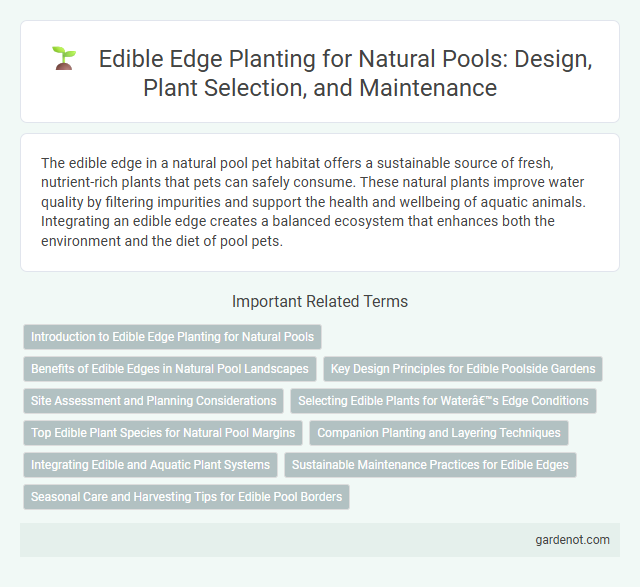The edible edge in a natural pool pet habitat offers a sustainable source of fresh, nutrient-rich plants that pets can safely consume. These natural plants improve water quality by filtering impurities and support the health and wellbeing of aquatic animals. Integrating an edible edge creates a balanced ecosystem that enhances both the environment and the diet of pool pets.
Introduction to Edible Edge Planting for Natural Pools
Edible edge planting integrates fruits, herbs, and vegetables along the perimeter of natural pools, enhancing biodiversity and water purification. These plants not only contribute to the ecosystem by filtering nutrients and pollutants but also provide fresh, organic produce directly from the water's edge. Selecting native, water-tolerant species like mint, watercress, and chives ensures sustainable growth and supports local wildlife habitats.
Benefits of Edible Edges in Natural Pool Landscapes
Edible edges in natural pool landscapes enhance biodiversity by attracting pollinators and beneficial insects that support ecosystem health. Incorporating plants such as herbs, berries, and edible flowers provides organic food sources while improving water quality through natural filtration. These edible margins create a sustainable, low-maintenance environment that combines aesthetic appeal with functional ecological benefits.
Key Design Principles for Edible Poolside Gardens
Edible edge design in natural pools emphasizes selecting diverse, native plants that thrive in wet environments, promoting biodiversity and water purification. Incorporating layered vegetation such as marginal plants, sedges, and aquatic herbs enhances nutrient absorption while providing habitat for beneficial insects. Strategic placement ensures easy harvesting and maintains water quality, blending aesthetic appeal with functional sustainability.
Site Assessment and Planning Considerations
Site assessment for edible edges in natural pools involves analyzing soil quality, sunlight exposure, and water flow to ensure optimal plant growth and ecosystem balance. Planning considerations include selecting native, water-tolerant edible plants that thrive in moist, marginal zones while enhancing biodiversity and water purification. Incorporating buffer zones minimizes nutrient runoff, promoting sustainable integration of edible vegetation with aquatic habitats.
Selecting Edible Plants for Water’s Edge Conditions
Selecting edible plants for water's edge conditions in a natural pool involves prioritizing species that thrive in moist, nutrient-rich environments while supporting local biodiversity. Suitable options include watercress (Nasturtium officinale), marsh mallow (Althaea officinalis), and lemongrass (Cymbopogon citratus), all known for their resilience and culinary uses. Incorporating native, non-invasive plants ensures ecological balance and enhances the natural filtration capabilities of the pool.
Top Edible Plant Species for Natural Pool Margins
Top edible plant species for natural pool margins include watercress (Nasturtium officinale), which thrives in moist environments and offers a peppery flavor, and marsh mint (Mentha aquatica), noted for its aromatic leaves ideal for culinary and medicinal uses. Other highly recommended species are creeping thyme (Thymus serpyllum), valued for its ground-covering ability and edible flowers, and chives (Allium schoenoprasum), which provide a mild onion taste and attract pollinators. Selecting these plants enhances biodiversity, supports ecosystem health, and provides fresh, edible greenery along natural pool edges.
Companion Planting and Layering Techniques
Edible edges in natural pools leverage companion planting by integrating herbs, vegetables, and flowers that support each other's growth, enhance pest control, and improve soil health. Layering techniques involve planting species of varying heights and root depths to maximize space efficiency and promote biodiversity within the pool's perimeter. This combination creates a resilient ecosystem that boosts plant productivity and contributes to water purification in the natural pool environment.
Integrating Edible and Aquatic Plant Systems
Edible edges in natural pools integrate edible and aquatic plant systems to enhance biodiversity and provide sustainable food sources. Combining nutrient-absorbing aquatic plants with herbs, vegetables, and fruit-bearing shrubs creates a balanced ecosystem that improves water quality and supports healthy plant growth. This approach maximizes space efficiency while promoting ecological harmony and resilience within the natural pool environment.
Sustainable Maintenance Practices for Edible Edges
Sustainable maintenance practices for edible edges in natural pools emphasize organic mulching, native plant selection, and minimal chemical use to promote healthy soil and biodiversity. Incorporating drought-tolerant, pest-resistant plants reduces water consumption and the need for synthetic fertilizers, fostering an eco-friendly ecosystem. Regular monitoring and manual weeding support natural growth cycles while preserving the delicate balance of aquatic and terrestrial habitats.
Seasonal Care and Harvesting Tips for Edible Pool Borders
Edible edges in natural pools require regular seasonal care to maintain plant health and optimize yields. In spring, prune dead foliage and enrich soil with organic compost to support vigorous growth, while summer demands consistent watering and pest monitoring for fruits and herbs. Harvest edible plants such as watercress, mint, and chives early in the morning for peak flavor and encourage new growth by selectively cutting back mature leaves.
Edible edge Infographic

 gardenot.com
gardenot.com